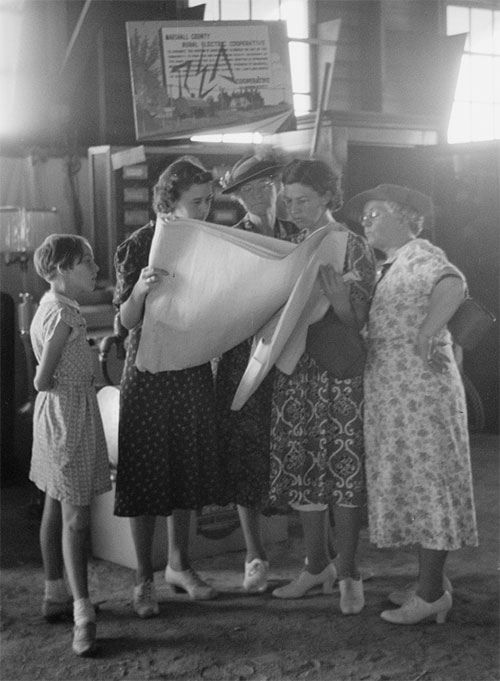Dakota Gasification Company
Headquarters:
1717 East Interstate Avenue | Bismarck, ND 58503-0564 USA
701.223.0441 | 1.800.242.2372
Great Plains Synfuels Plant
420 County Road 26
Beulah, ND 58523-9400 USA
701-873-2100
A subsidiary of:
The publication The Next Greatest Thing was conceived by staff members at the National Rural Electric Cooperative Association in 1985 as a way to recognize the Rural Electrification Administration’s (REA) 50th anniversary. Three years of research were put into the making of the publication. The Next Greatest Thing recognizes the bumpy road the REA traversed over in the construction of their institution, including where we were before electricity, how they were started, and how we got to where we are today. This blog post is an excerpt from The Next Greatest Thing to examine how women were influenced by electricity. All information and quotes in this post were gathered from The Next Greatest Thing.
Life prior to electricity was difficult for both the farmer and his wife. The book, The Next Greatest Thing, detailed how the Country Life Commission Report of 1909 brought attention to the difficulties of life, specifically for women. “The report was particularly critical of the lot of the rural woman: ‘The burden of the hardships fall most heavily on the farmer’s wife than on the farmer himself. Her life is the more monotonous and the more isolated, no matter what the wealth or poverty of the family may be…’” (page 41). What the report was referring to was a woman’s work day which would consist of hours slaving over a fire in the dead heat of summer.
The farmer’s wife’s tasks would consist of ironing, washing clothes, canning fruit and vegetables, finishing extra tasks, like sewing, until the children were in bed. While those tasks may not seem as daunting today, these jobs were quite the chore during that time period. All of these tasks required constant heat which was provided through a continual fire. “A woman would have to keep a constant watch on the fire, thrusting logs – or corncobs, which ignited quickly into the firebox every time the heat slackened,” (page 19). Ironing consisted of the use of three to four different irons that had to be placed on heat and replaced when one would get cool and would no longer flatten the clothing. Washing clothing meant three different wash basins, all filled with hot water that had been heated by the stove she would be keeping hot. Canning fruit and vegetables entailed mashing of food to be put into jars, jars that had been sanitized in boiling water over her stove. She wouldn’t be able to take a rest because a rest would mean a fruit or vegetable going bad so she had to remain vigilant while canning. Canning was also a necessity because there was no refrigeration and food would go bad quickly. Finally, she would be up late into the night finishing her sewing for the day because she had given the children the lantern to use for homework earlier in the day.

When electricity started to make its way across the country, the teams who were setting up the co-ops to get farmers to sign up for their services, learned to target the farmers whose wives were present at the sign up. “They looked at her when they talked about lights to help the children study or when they described electric refrigeration. Often the wife would pay the sign-up fee before the organizers had finished arguing with the husband,” (pages 82-87). Once the teams realized how influential women could be to the expanding of electricity, they often recruited women to be on the team. One female figure they had as a part of the teams was, “‘Granny’… One balking farmer who was finally convinced: ‘If such a sweet little old lady is so dead set on it, why I guess I’ll go along’,” (page 87). As part of the sign-up teams, women began to make their mark on the introduction of electricity to the rest of the United States.
The Next Greatest Thing explained how influential women were in the co-ops as the bookkeepers. These women had a variety of duties while working in the co-op. When the manager was away checking on the co-op’s project, the bookkeeper kept things running in the home office. She would communicate with any individuals who were having problems, pitched irons and washing machines to farm wives, and sent out newsletters to members. When the managers went off to war, the bookkeeper would typically take over the co-op as manager. “The co-op folks called the young bookkeeper-turned-manager the “‘lectric light lady.” During her long, ‘temporary’ tour of duty, she put the system in the ‘black’ for the first time, something the first manager had been unable to do. But he knew he had left the co-op in good hands,” (pages 139-140).
Editor's note: This post has been republished in honor of National Women's History Month. We published this blog post on Oct. 11, 2018, on an earlier version of Basin Electric: Live Wire.
Dakota Gasification Company
Headquarters:
1717 East Interstate Avenue | Bismarck, ND 58503-0564 USA
701.223.0441 | 1.800.242.2372
Great Plains Synfuels Plant
420 County Road 26
Beulah, ND 58523-9400 USA
701-873-2100
A subsidiary of:
Basin Electric wants all interested and qualified candidates to apply for employment opportunities. If you are an applicant with a disability who is unable to use our online tools to search and apply for jobs, or who needs other assistance or accommodations, please contact us at 701-223-0441. Please indicate the specifics of the assistance needed or provide your contact information, and a Basin Electric Human Resources representative will contact you. Basin Electric is an Equal Employment Opportunity Employer regarding race, color, religion, sex, sexual orientation, gender identity, national origin, disability, and veterans status.